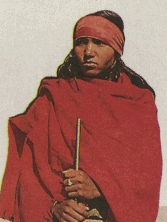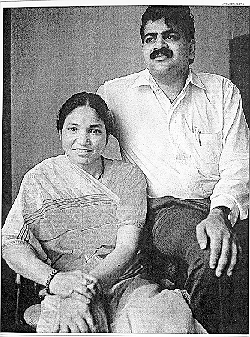They called her the
Bandit Queen; she is the subject of a discrediting movie by Indian director, Shekhar
Kapur; some remain convinced that she was an incarnation of Durga, the Hindu goddess
of power (shakti). At 26, she became India’s most famous dacoit, or outlaw, who would go on to become a member
of parliament. But who is the notorious “Bandit Queen,” famed for her sheer defiance
against India’s age-old racist and sexist caste customs? Phoolan Devi was born
in 1963, in Gorha Ka Purwa, Uttar Pradesh, a tiny hamlet on the
sacred Yamuna River, to a fisherman’s family who belonged to the Mallan caste—one of
the lowest. In a geography where daughters meant ill fortune and a plot of land
meant everything, she was the second of four daughters born to her parents who
owned a mere one-acre of land. Her father had inherited 15 acres but lost this
to the connivance of his brother and his brother’s well-connected son, Maiyadin.
Merely 10 years of age,
Phoolan demanded that her father fight for this land, but the old man lacked socio-political
creditability and complained that he was too weary to fight—so the child confronted
her cousin. Once, with her older 12-year-old sister, she staged a sit-in on the
disputed territory—until one day, Phoolan was beaten with a brick by her nemesis
until she lost consciousness. Like most low-caste
Indian women who are treated merely as engines for procreation and working the
land of upper-caste landowning families, Phoolan is married off at age eleven—to
a widower in his thirties in exchange for a cow. After a few months of being beaten
and raped, she committed the great taboo for Indian wives in deserting her abusive
husband. Returning to her village, Phoolan’s mother demanded she commit suicide,
but the child refused, becoming instead, an outcast coming and going from the
village. As she came of age, she developed a reputation for being promiscuous,
even marrying a cousin (who was already married) temporarily. It was rumored that
she even took baths naked in the Yamuna. Meanwhile, the epic
battle between rival cousins continued. Young Phoolan argued her case in the Allahabad High Court.
To remove her, Maiyadin concocted a theft at his home, and had Phoolan arrested
by his police friends. She was jailed for one month—and as typical with female
inmates, is beaten and raped repeatedly. In her own words, she had become “a whimpering
piece of rubbish in the corner of a dirty room with rats staring in my eyes.” When she emerged from
behind bars, the relentless Maiyadin plotted again. Though this is murky detail,
it is common belief that he paid a gang of outlaws (led by the fearsome Babu Gujar)
who kidnapped Phoolan. Gujar tortured the adolescent woman for two consecutive
days until one of his deputies, Vickram Mallah, shot and killed the Thakur (a
Brahmanical order and of a higher caste) leader. Mallah assumed leadership of
the gang, making Phoolan his lover and second in charge. As a dacoit who carried
a Durga figurine in her pocket, she learned the trades of the outlaw, including
the art of the rifle—Phoolan became a crack shot. In India’s sprawling poor communities where caste gangs operate tenaciously,
life is dictated by one-sided caste rules; the lower castes exist at the whim
of the uppers. Lower-caste women especially suffer in being targeted for rape
and murder. Where primarily men are concerned as in gangs, the rules still remain
the same; because both Phoolan and Mallah were of a lower caste (Mallan), and
led primarily Thakur men, it was expected that upper-caste envy would bring some
form of retaliation. Especially when the
power Phoolan held translated into a brutal campaign of attacks on upper-caste
villages and homes—sharing the spoils with the villagers or lower castes. Her
gang made the sandy ravines and jungles of Uttar and Madhya Pradesh their home,
moving across rough terrain, eluding rival gangs. But in 1980, two Thakur brothers,
Sri and Lala Ram, members of Gujar’s gang before Phoolan was kidnapped, were released
form jail. The brothers found the group, managed to kill Mallah in an ambush,
and kidnapped Phoolan.  
India’s “Bandit
Queen,” a renegade freedom fighter and outlaw. Unknowing to her, she
is imprisoned in Behmai, an obscure Thakur village. Each night for two weeks,
a group of Thakur men gang-raped Phoolan, most times until she lost consciousness.
One day the Ram brothers stripped the weakened captive naked and forced her to
fetch them water from the village well—while the villagers watched. Thakur authority
had been restored. Temporarily at least—for that night, while no one watched,
a pandit from a nearby village carried her away. The Bandit Queen never
found the Ram brothers, but almost two years later, she stumbled upon Behmai to
rob the villagers. What began as a robbery transformed into an inquisition when
Phoolan recognized two of the men as part of the gang that had raped her. When
the villagers failed to disclose the whereabouts of the Ram brothers, an infuriated
Phoolan assembled the men in a line and opened fire. Of the thirty men who crumbled,
twenty-two died in what became known as the St. Valentine massacre. An act of pure retribution,
it was the largest massacre by an outlaw in India’s history, capturing the attention of Prime Minister Indira Gandhi,
and thousands of policemen who came after her. In social terms, upper caste power
had not only been threaten, it was humiliated, beaten
back—even if only for a moment in a long history of upper-caste domination. While
uppers regarded Phoolan as a ruthless murderer—for millions of untouchables, this
Apache-looking, bandana wearing, gun-slinging outlaw had become a devi—a
goddess among them. By 1983, although the
extensive hunt by both police and rival gangs had failed to capture the scourge
of upper caste villages, the loop was tightening. Outlaw life was taking its toll
on her weather-beaten body, and many of her gang members were either dead or weary
from a life on the run. That year, aided by Gandhian peace activists, she managed
a deal with the Indian government and relinquished her rifle to unarmed policemen
before a crowd of 10,000, including foreign journalists. Other conditions that
had to be met included her surrender being done in the presence of two huge portraits
of Durga and the Mahatma. Her father’s land was to be returned, her only brother
be given a government job, and her gang members were not to be hanged or tried
in Uttar Pradesh—but were to serve 8 years and be freed thereafter. With
Indira Gandhi assassinated in 1983 and her family without money for legal challenges,
Phoolan “rotted” in jail for 11 long years that further deteriorated her health.
Her enemies piled up cases against her, and her gang members, mostly Thakur men
from families with both connection and money, requested trials (against her wish)—events
that became mere loopholes that allowed them to walk free. Eventually in 1994,
the new minister of state of Uttar Pradesh who was also of a low caste, pardoned
Phoolan of all charges against her. Free but frail, she plunged into politics—winning
a parliamentary seat in 1996 to represent again, the untouchables—especially the
women, whom she knew had no political representation, a fact made very obvious
when she was asked by a Western journalist about being raped:
“You can call it rape
in your fancy language. Do you have any idea what it's like to live in
a village in India? What you call rape, that kind of thing happens to poor women in
the villages every day. It is assumed that the daughters of the poor are for the
use of the rich. They assume that we're their property. In the villages the poor
have no toilets, so we must go to the fields, and the moment we arrive, the rich
lay us there; we can't cut the grass or tend to our crops without being accosted
by them. We are the property of the rich…they wouldn't let us live in peace;
you will never understand what kind of humiliation that is. If they wanted to
rape us, to molest us, and our families objected, then they'd rape us in front
of our families.” As
an MP in her modest home, her walls carried portraits of heavyweights with whom
she very much aligned her philosophy of social justice—Mahatma Gandhi, Buddha,
Jesus, Durga, and Bhimrao Ambedkar—the most important voice of untouchable rights—besides
Indian’s “great soul.” Very aware that she had numerous enemies, Phoolan the public
official had a dog at home (who bit her new husband) in spite of her guards. Aside
from her bodyguards in a public where her adversaries lurked freely, she now depended
on a bulletproof vest whereas before she carried an Enfield rifle and bandoleer.
Inevitably, such dependency was undependable for such a marked figure—and in July
2001, the assassins found their mark because this little, impoverished fisherman’s
daughter who once dominated some of India’s most treacherous landscape, and whose
cunning eluded thousands, was found under the Delhi sky without her vest.  Phoolan
Devi with her husband, after release from prison. A
violent death reflecting a life filled with violence. It seemed logical, yet,
however long we may remember Phoolan and however brutal the “Bandit Queen” may
have seemed, she was a civilian in a class of her own as a renegade freedom fighter.
In a ruthless landscape where lawless is law, there is no doubt that the rifle
and her body became the equivalent of Gandhi’s salt and homespun cloth. She had
single-handedly confronted and debunked India’s centuries-old caste system—suffering
repeatedly, the worse humiliation possible in her defiance of its ancient orders.
Instead of academic brilliance or regal connections—there were only her sense
of right and, as she claimed, “anger.” It is difficult to comprehend
extraordinary lives using mundane contemporary standards, especially a life like
Phoolan’s that seemed so impossible at times, one is tempted to have doubts—but
one should not even attempt to make this mistake. While the Indian mind is never
without its myth or mystic, the life of Phoolan Devi assumes, rightfully, mythic
proportions. In India where numerous centuries of old stifling social customs operate at
any given moment, where saints must compete with criminals for posterity, and
where the subjugation of women is as raw as the worship of deities, it is all
these things and more that constitute to the trespassing by this untouchable “queen”
of the Indian reality.
<<< Page X
Page
X>>> |


